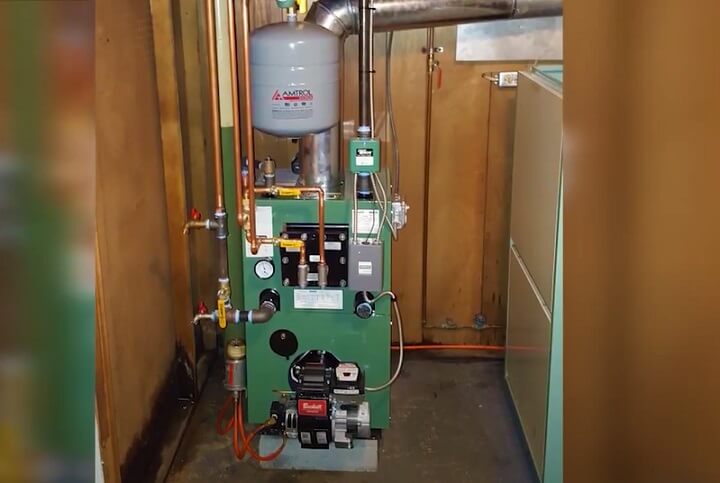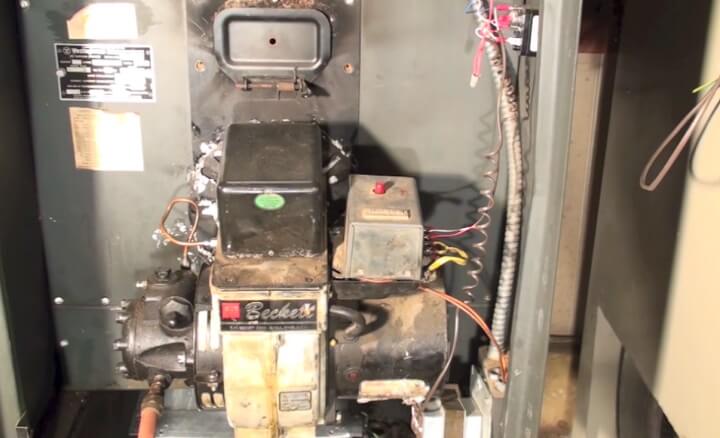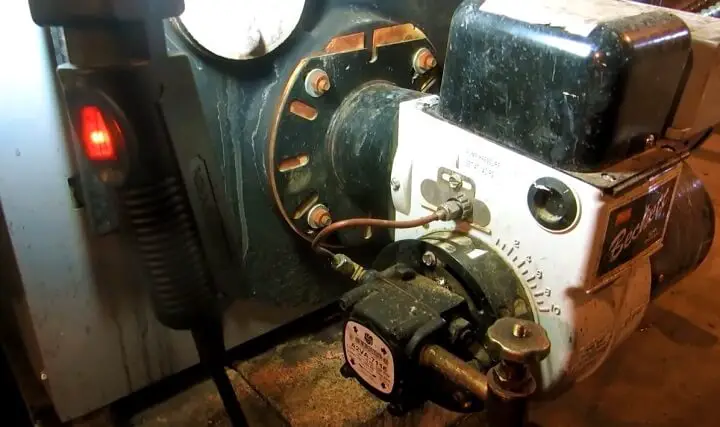Note: This article may contain affiliate links, which means if you make a purchase following our links won’t cost you extra, but we may earn a commission. Learn more
When your oil furnace starts to have problems, it can be a very frustrating and overwhelming experience. There are a few different things that can go wrong with your oil furnace, and each problem can lead to different feelings. You may not know what is wrong with it or how to fix it, and you may start to feel like you are in over your head.
If your furnace isn’t igniting, you may feel frustrated because you can’t get the heat you need. If your furnace is igniting but the flame keeps going out, you may feel anxious because you’re worried about the safety of your home. If your furnace is running but not providing enough heat, you may feel cold and uncomfortable.
However, there are some things that you can do to try to troubleshoot and fix your furnace, and this article will give you some tips on how to do that.

Common Oil Furnace Problems
If you have an oil furnace, you know they can be temperamental. One day it’s working fine and the next day it’s not. When something goes wrong with your oil furnace, it can be frustrating trying to figure out what the problem is.
To help you troubleshoot common oil furnace problems, here are 12 of the most common issues along with what you can do to fix them.
If you have an oil furnace, you know that it can be a great way to heat your home. However, like any other type of furnace, oil furnaces can have their share of problems. Here are some common oil furnace problems and what you can do about them:
1. Pilot Light Issues
If your oil furnace has a pilot light that won’t stay lit, it could be a problem with the thermocouple. The thermocouple is a heat-sensing device that tells the oil furnace when the pilot light is lit.
If the thermocouple is not working, it will shut off the flow of oil to the burner, causing the pilot light to go out. To fix this problem, you will need to replace the thermocouple.
2. Dirty Burner
If your oil furnace has a dirty burner, it will not operate as efficiently as it should. The burner is the part of the furnace that burns the oil, and if it is dirty, the oil will not burn as cleanly or as efficiently. To clean the burner, you will need to shut off the power to the furnace, remove the burner assembly, and clean it with a brush.
3. Clogged Fuel Line
If your oil furnace has a clogged fuel line, it will not be able to get the oil it needs to run. The fuel line delivers oil to the burner, and if it is clogged, the furnace will not be able to operate. To clean the fuel line, you will need to shut off the power to the furnace, remove the fuel line, and clean it with a brush.
4. Thermostat Problems
If your furnace isn’t heating properly, it could be due to thermostat problems. You should make sure that your thermostat is working properly and that it’s set to the correct temperature for your home.
5. Strange Odors
If you notice a strange, burning smell coming from your oil furnace, it could be due to a problem with the oil burner. If the burner isn’t working properly, it could cause the oil to overheat and produce a burning smell. If you notice this problem, you should contact a furnace repair technician to have the burner repaired or replaced.
6. Yellow Flames
If you notice that the flames from your oil furnace are yellow instead of blue, it could be a sign that the furnace isn’t burning the oil properly. Yellow flames can indicate that the furnace is producing too much carbon monoxide, which can be dangerous. If you notice this problem, you should contact a furnace repair technician to have the furnace serviced.
7. Soot Around the Furnace
If you notice soot around the furnace, it could be a sign that the furnace isn’t burning the oil properly. Soot is a byproduct of incomplete combustion, and it can be dangerous if inhaled. If you notice this problem, you should contact a furnace repair technician to have the furnace serviced.
8. High Carbon Monoxide Levels
If you notice that the carbon monoxide levels in your home are higher than normal, it could be a sign that your oil furnace isn’t burning the oil properly. Carbon monoxide is a poisonous gas that can be dangerous if inhaled. If you notice this problem, you should contact a furnace repair technician to have the furnace serviced.
9. Decreased Heat Output
If you notice that the heat output from your oil furnace is less than it used to be, it could be a sign that the furnace isn’t burning the oil properly. This can be caused by several different problems, so you should contact a furnace repair technician to have the furnace serviced.
10. Increased Fuel Consumption
If you notice that you’re using more fuel than usual, it could be a sign that your oil furnace isn’t burning the oil properly. This can be caused by several different problems, so you should contact a furnace repair technician to have the furnace serviced.
11. Frequent Cycling
If your oil furnace is cycling on and off more frequently than usual, it could be a sign that the furnace isn’t burning the oil properly. This can be caused by several different problems, so you should contact a furnace repair technician to have the furnace serviced.
12. Loud Ignition
If you hear a loud bang when the furnace starts up, it’s likely due to the ignition system. The ignition system can become dirty and need to be cleaned. To clean it, you’ll need to shut off the power to the furnace and remove the access panel. Locate the ignition system and clean it with a wire brush. Be sure to check the manufacturer’s instructions before doing any work on the ignition system.
Learn More: The Best Oil Lantern For A Power Outage: Our Top 6 Picks
What Would Cause an Oil Furnace to Stop Working?
If your oil furnace stops working, there are a few potential causes. The first thing you should check is whether or not there is fuel in the tank. If the tank is empty, then you’ll need to refill it before the furnace will work again.
Another potential cause is a dirty air filter. A clogged air filter can restrict airflow and prevent the furnace from igniting. Be sure to check the air filter and clean or replace it if necessary.
An oil furnace may stop working if the oil burner itself is dirty. Over time, dirt and debris can build up on the burner, preventing it from functioning properly. You’ll need to clean the burner (following the manufacturer’s instructions) to get it working again.

How Long Does an Oil Furnace Usually Last?
An oil furnace usually lasts about 15-20 years. However, this can vary depending on how well the furnace is maintained and how often it is used. If a furnace is not properly maintained, it may only last 10-12 years.
What are Common Problems With Furnaces?
If your furnace is having problems, it’s important to troubleshoot the issue as soon as possible. After all, furnaces are essential for keeping homes warm during the cold winter months. Common problems with furnaces include:
1. The furnace doesn’t turn on. This could be due to a variety of issues, such as a tripped circuit breaker or a blown fuse. Check your home’s electrical panel to see if there are any outages. If not, then the problem may lie with the furnace itself.
2. The furnace turns on, but the fan doesn’t run. If the fan isn’t running, then hot air won’t be circulated through your home. This could be caused by a faulty fan switch or motor.
3. The furnace turns on and the fan runs, but there’s no heat being produced. This could indicate that your furnace is low on fuel or that the pilot light has gone out.
4. The furnace turns on and produces heat, but it cycles on and off too frequently (short cycling).
How Do I Reset My Oil Burner?
If your oil burner is not working, it may need to be reset. To do this, make sure that the power switch is in the “on” position and that there is oil in the tank. If the burner still does not start, you will need to find the reset button.
This is usually located on the side of the unit near the bottom. Once you have found the reset button, press and hold it for three to five seconds. If the burner starts, you can release the button.
If it does not start, you may need to press and hold the button for a longer period or contact a technician for assistance.
Symptoms of Bad Oil Burner Electrodes
If your home has an oil-burning furnace, stove, or boiler, you may be familiar with the term “oil burner electrodes.” These are small metal rods that create an electrical arc between them. This arc ignites the oil mist that’s sprayed into the combustion chamber, where it burns to heat your home.
Like any other electrical component, oil burner electrodes eventually wear out and need to be replaced. But how do you know when they’re starting to fail? Here are some telltale signs:
Increased soot: If you notice more soot around your furnace than usual, it could be a sign that your electrodes are wearing out. As they degrade, they become less efficient at igniting the oil mist, which can cause more unburned oil to end up in the combustion chamber and produce more soot.
Yellow flames: Healthy flames should be mostly blue with just a bit of yellow at the tips. If your flames are mostly yellow (or orange), it’s another sign that your electrode tips are worn and aren’t igniting all of the oil mist properly.
Higher fuel bills: If it seems like you’re using more fuel than usual but your heating habits haven’t changed, worn electrodes may be to blame. Inefficient burning due to electrode wear can increase fuel consumption by as much as 15%. If you notice any of these symptoms, it’s time to replace your oil burner electrodes.
Troubleshooting Oil Heating Quizlet
If your home is heated with oil, you know that it’s important to keep an eye on your tank and make sure you don’t run out of fuel. But what do you do if something goes wrong with your oil heater? This troubleshooting quiz will help you identify the problem and find a solution.
1. My heater isn’t working at all. What could be the problem?
There are several possible reasons why your heater might not be working. First, check to see if there is any oil in the tank. If the tank is empty, you’ll need to refill it before the heater will work again.
If there is oil in the tank, check to see if the power is turned on and whether the pilot light is lit. If neither of these things is working, you may need to call a technician for help.
2. My heater is making strange noises. What could be causing this?
If your heater starts making strange noises, it could be an indication that something is wrong with the unit itself. It’s important to have a technician take a look at it as soon as possible so they can diagnose and fix the problem before it gets worse.
Beckett Oil Burner Troubleshooting

If your Beckett oil burner isn’t working properly, check the oil tank to make sure there is enough fuel. If the tank is empty, fill it up and try again.
Then, check the oil filter to see if it needs to be replaced. If the filter is clogged, it will need to be replaced. And, check the air intake and exhaust for any blockages.
If you find any blockages, clear them and try restarting the burner.
